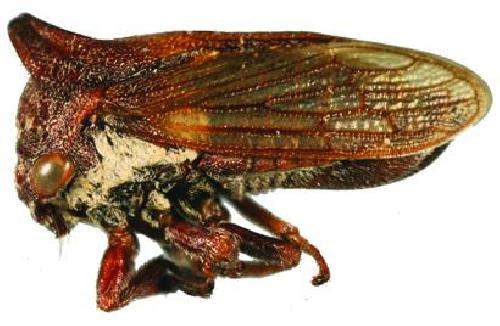Insects known as treehoppers vary wildly in form, sporting many different shapes and colors.
Recently, Dr. Brendan O. Morris and Dr. Christopher H. Dietrich, of the University of Illinois at Urbana-Champaign, discovered a new treehopper genus (and its single species) that is found in Texas and northern Mexico, which they describe in an article in the Annals of the Entomological Society of America.
They named the new genus Selenacentrus after the singer Selena Quintanilla, who was known as the "Queen of Tejano Music." The new species is called wallacei in honor of Matthew S. Wallace, a biology professor from East Stroudsburg University.
 This is Selenacentrus wallacei, a newly discovered genus and species of treehopper found in Texas and Northern Mexico. They new genus is named after the singer Selena Quintanilla, who was known as the 'Queen of Tejano Music.' The new species is called wallacei in honor of Matthew S. Wallace, a biology professor from East Stroudsburg University. Credit: Entomological Society of America
This is Selenacentrus wallacei, a newly discovered genus and species of treehopper found in Texas and Northern Mexico. They new genus is named after the singer Selena Quintanilla, who was known as the 'Queen of Tejano Music.' The new species is called wallacei in honor of Matthew S. Wallace, a biology professor from East Stroudsburg University. Credit: Entomological Society of America
The scientists discovered Selenacentrus wallacei after examining 45 specimens of mislabeled treehoppers that were borrowed from collections at the Illinois Natural History Survey, the United States National Museum of Natural History, the American Museum of Natural History, Texas A&M University, and the University of Missouri.
Treehoppers are found on all major landmasses except Antarctica and Madagascar. Numbering about 3,500 species in 300 genera, they are divided into three families: Aetalionidae, Melizoderidae, and Membracidae. All treehoppers feed on plant sap by sucking it out with piercing mouthparts. They feed on more than 100 herbaceous and woody plant species. Some treehoppers exude sweet "honeydew" from excess consumed sap, which they share with ants in a mutualistic relationship, the ants swilling honeydew and protecting the treehoppers from predators. Some treehoppers are also known to form mutualistic relationships with wasps and bees.
source: Entomological Society of America